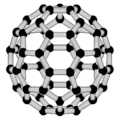|
Aluminium oxide nanoparticle
Nanosized aluminium oxide (nanosized alumina) occurs in the form of spherical or nearly spherical nanoparticles, and in the form of oriented or undirected fibers. PropertiesProperties, of the final material, defined as the set of properties of the solid Aluminium oxide and specific properties of nanostructures. Properties of nanoscale colloidal alumina particles:
Properties of the nanoscale fibers of aluminium oxide:
ProductionMethods of obtaining powders of aluminium oxide nanometer scale 1. Grinding powder alumina particles of a nanometer level (for example, 10-50 nm). For example, using a planetary mill using grinding bodies of size less than 0.1 μm. 2. The decomposition of fresh chemically-synthesized AlOOH or Al(OH)3 to aluminium oxide in the rapid achievement of the temperature of decomposition 175 °C and use for it the pressure of 5 bars within thirty minutes. The sooner of the temperature of decomposition of the hydroxo-compounds of aluminium is achieved, the smaller the resulting particles nano oxide in size. Alumina nano fibersThe oxidation of the surface of some liquid metal alloys leads to the formation of loose or porous 3D nanostructures. For the first time this effect was observed in the system aluminium-mercury and published more than 100 years ago.[1] The fibers of such kind do not occur in nature and only grown by artificial means. Depending on the method of synthesis can be produced various nanostructures, such as aerogel from oxyhydroxide aluminium (AlOOH or , where , are easily turned into aluminium oxide) or nano-fibers of aluminium oxide (Al2O3). At this moment, the main ways of production are:
Application
In addition to these areas, used as a catalyst and carrier of catalysts. Nanoscale oxide due to the small diameter of the particles/fibers, high specific surface area and activity associated with the defects, and the specific structure of the nanoparticles (the volume and size of pores, degree of crystallinity, phase composition, structure, and composition of the surface) strongly enhances the catalytic properties, and increases the range of massive aluminium oxide as a catalyst. Literature1. Wislicenus, H. Zeitschrift für chemie und industrie der kolloide Kolloid-Z 2 (1908): XI-XX. 2. Vignes, J-L. Mazerolle, L., Michel, D. Key Engineering Materials 132-136 (1997): 432 – 435. 3. Zhu, Huai Yong, James D. Riches, and John C. Barry. γ-alumina nanofibers prepared from aluminum hydrate with poly (ethylene oxide) surfactant // Chemistry of Materials 14.5 (2002): 2086-2093 4. Azad, Abdul-Majeed. Fabrication of transparent alumina (Al2O3) nanofibers by electrospinning // Materials Science and Engineering: A 435 (2006): 468–473. 5. Teoh, Geik Ling, Kong Yong Liew, and Wan AK Mahmood. Synthesis and characterization of sol–gel alumina nanofibers // Journal of Sol-Gel Science and Technology 44.3 (2007): 177–186. 6. В, Петрова Е.; Ф, Дресвянников А.; А, Цыганова М.; М, Губайдуллина А.; В, Власов В.; Г, Исламова Г. (2008). "E. V. Petrova, A. F. Dresvyannikov, M. A. Tsyganov, Gubaidullina A. M., Vlasov V. V., Islamov G. G. nanoparticles of hydroxides and oxides of aluminium, obtained by electrochemical and chemical methods // Bulletin of Kazan Technological University. 2008. (Date accessed 10.04.2017)". Вестник Казанского Технологического Университета (6): 55–67. See alsoReferences
External links |


